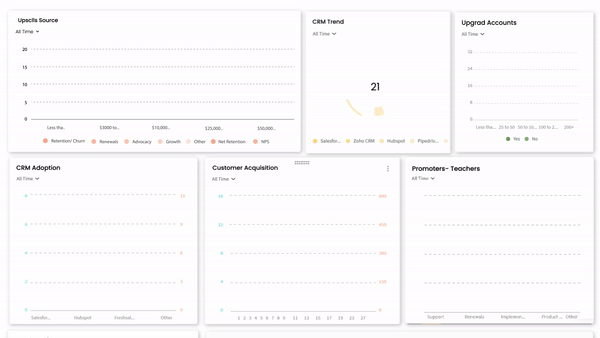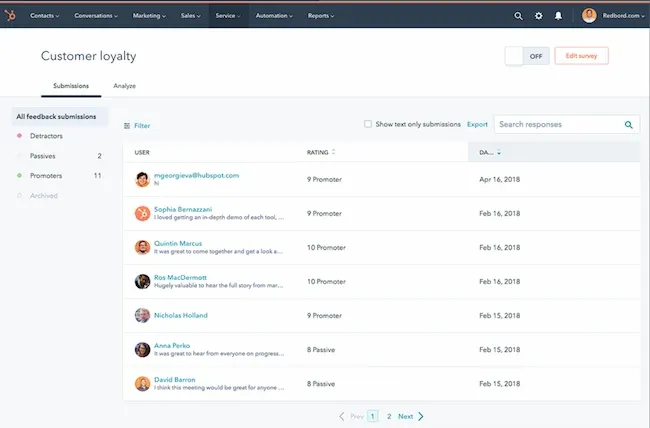Customer Experience
Customer Experience Metrics: What Are They & How to Measure Them
Article written by Mathew Maniyamkott
Regular contributor to various magazines. Passionate about entrepreneurship, startups, marketing, and productivity.
14 min read
19 September 2025

Have you ever wondered what makes some brands unforgettable? Why some companies keep their customers coming back for more while others struggle to hold on? The secret lies in how they use Customer Experience (CX) metrics.
We are not talking about just measuring performance but actually shaping the customer journey.
We’ll break down the CX metrics that matter most and go beyond the basics. You’ll learn:
- What are the different key CX metrics
- The tools you can use for measuring
- How to use these metrics effectively.
So, let's get started!
TL;DR
- CX metrics track customer satisfaction, loyalty, and effort. They highlight how customers feel about your business and pinpoint key touchpoints in their journey.
- Two types of CX metrics: Qualitative and Quantitative.
- There are six major metrics - NPS, CSAT, CES, CLTV, Retention Rate & Churn Rate.
- SurveySparrow is Best for CSAT, NPS, CES via engaging surveys.
- HubSpot is Ideal for tracking CLTV, retention, and churn with in-depth analytics.
What Are CX Metrics?

CX metrics, or Customer Experience metrics are KPIs you track to measure your CX. It helps you understand how customers feel about your business. More importantly, it offers insight into where or at which touchpoints in their journey they felt it.
Think of it as a dashboard for understanding your customers' perspectives. They guide you by answering key questions:
- Are customers satisfied with your product or service?
- How likely are they to recommend your brand to others?
- Are they facing difficulties during their interactions?
Types of CX Metrics
There are two main types of metrics to keep track of. They are quantitative and qualitative. Read on to learn more.
1. Quantitative Metrics
Quantitative metrics are numbers-driven and provide measurable insights into customer behavior and satisfaction. They answer the "what" questions—what is happening in the customer journey, and how significant is the impact?
NPS, CSAT, and CLTV are some examples of quantitative CX metrics.
2. Qualitative Metrics
While quantitative metrics provide the "what," qualitative metrics answer the "why." They focus on capturing open-ended feedback and observations to reveal customers' emotions, expectations, and experiences.
Online reviews and user interviews are a couple of examples of qualitative CX metrics.
Both quantitative and qualitative metrics are equally important, and they work best when used together. Here's why:
- Numbers Provide the Scale: Quantitative metrics give you a broad overview of trends and highlight priority areas. For example, a low NPS score signals a loyalty problem.
- Qualitative Data Provides the Depth: Qualitative feedback explains the reasons behind the trends. For example, survey comments might reveal that customers are unhappy with product quality, driving the low NPS.
Now, let's have a look at the key metrics you need to keep track while measuring CX.
Key CX Metrics to Track
It's possible that you already know the parameters we are going to explain here. Still, we don't want to assume anything, so we will be discussing each metric in detail.
1. Net Promoter Score (NPS)

Understanding NPS Beyond the Basics While most CX professionals know NPS measures loyalty and brand advocacy, it’s more than just a score. It’s a predictor of growth.
It all start with asking the right question. For example, On a scale 0-10, How likely are you to recommend our services to your friends or family?
Based on the rating, the users can be distinguished into Promoters, Passives, and Detractors.
If you have a positive NPS score, it means that you have more promoters than detractors. Therefore, brands with a high NPS often outperform their competitors in market share and customer retention.
However, we suggest that you don’t obsess over a single NPS score. Instead, track trends over time. A dip might indicate emerging issues, even if the score is still above industry benchmarks.
Just keep in mind that NPS results can vary by culture. For instance, customers in some regions (like Japan) tend to rate conservatively, while others (like the US) are more generous. Adjust your benchmarks accordingly.
2. Customer Satisfaction Score (CSAT)

A typical customer satisfaction survey question looks like this -
"How satisfied are you with our mobile app?”"
You can rate it on a scale from 1 to 5 or 1 to 10. Depending on your score, we can understand the satisfaction level. But this isn't everything, you need to go deeper.
Going deeper with CSAT doesn't mean you are only looking for satisfaction. CSAT score is a reflection of whether you’re meeting immediate customer expectations. But what happens when CSAT is consistently high, yet customers still leave?
Well, if it comes to this, consider comparing short-term and long-term satisfaction. CSAT reflects short-term interactions (e.g., a resolved support ticket). Pair it with longer-term metrics like NPS or retention rates to see if satisfaction translates to loyalty.
Also, drill down into the CSAT drivers.
- Analyze what’s driving satisfaction. Is it product quality, customer service, or ease of use?
- Use text analytics tools to identify recurring themes in survey comments for more precise action.
Finally, when you send a survey matters. For example, immediately post-interaction surveys often show inflated scores due to a "honeymoon effect." For a more accurate picture, follow up after a few days.
3. Customer Effort Score (CES)

If you have to put a lot of effort into interacting with a business, would you stay with them? Probably not. That's why customer effort score matters.
CES measures how easy it is for customers to complete a task or resolve an issue, with questions like:
“How easy was it for you to find your ideal product?”
The lower the score, the easier it is for customers to interact. This easiness makes the customers feel valued and satisfied - mounting up to better CX.
Bear in mind that one interaction means nothing. You have to track and analyze this effort at multiple touchpoints.
4. Customer Lifetime Value (CLV)

The total revenue a customer is expected to generate throughout their entire time with your business that's what CLV represents.
Therefore, higher CLV indicates successful customer retention and upselling efforts.
Here's a formula to calculate the customer lifetime value
CLV = (Average Purchase Value) × (Average Purchase Frequency) × (Customer Lifespan)
But, CLV isn’t just a financial metric. It’s merely a tool to guide your business strategy. Customers with high CLV often generate more profit than those acquired cheaply.
The best way to track is to identify high-CLV customers and analyze their behaviors. Are they buying premium products, engaging with support less frequently, or responding to upsell offers? You can use these insights to replicate success across other segments.
Also, tailor experiences based on purchase history, preferences, or lifecycle stage. For instance, send high-CLV customers early access to new products or exclusive offers.
5. Churn Rate

The churn rate measures the percentage of customers who stop doing business with you over a given period.
A high churn rate indicates issues with customer satisfaction, engagement, or loyalty.
It’s more like an early warning system for underlying issues.
Also, keep in mind that it’s not just about losing revenue. Churn impacts customer acquisition costs (CAC), as replacing lost customers is often more expensive than retaining them. Therefore, keep watch of these following early warning signs.
- Decreased product usage.
- Longer gaps between purchases.
- Negative feedback on support interactions.
6. Customer Retention Rate

Retention rate tracks the percentage of customers who continue to do business with you over time.
Formula to calculate this is -
Retention Rate = [(Customers at End of Period - New Customers) ÷ Customers at Start of Period] × 100
Retention, in general, measures loyalty more directly than satisfaction. A high retention rate often correlates with high customer lifetime value.
One of the best ways to track performance here is to track retention rates by customer segment or acquisition channel. For example, customers acquired through referrals may have higher retention rates than those acquired through ads.
Not to mention how crucial the onboarding process is for retention. Poor onboarding often leads to early churn. Provide personalized guidance, FAQs, and follow-ups to set customers up for success.
Tools to Measure CX Metrics: SurveySparrow and HubSpot
Tracking the CX metrics we listed in the previous section is not an easy task. You need to have tools that excel in capturing, analyzing, and presenting data in actionable formats. Based on hands-on experience, SurveySparrow and HubSpot are the ones ideal for the job.
Here’s how these tools deliver value.
Using SurveySparrow for CSAT, NPS, and CES
SurveySparrow specializes in creating engaging surveys and gathering real-time feedback. The AI function makes it very easy to create surveys from scratch - in seconds. Furthermore, it's advanced automation features make it the go-to choice for metrics that rely heavily on direct customer responses.
From WhatsApp and SMS to offline, the tool allows for a multichannel distribution of surveys. Thus, you can reach out to the customers through their desired channels and collect feedback.

Its real-time analytics dashboard helps track trends and uncover patterns in satisfaction levels. Additionally, you can set triggers to address negative feedback immediately, preventing minor issues from escalating.

It also simplifies NPS tracking by automating survey delivery at key intervals in the customer lifecycle. Moreover, it offers more than just categorization of respondents.
It can analyze open-ended responses and interpret qualitative feedback. This makes it easier to pinpoint why customers feel a certain way, enabling targeted improvements.

With conditional logic and conversational surveys, you can make the process engaging as well. Also, it supports over 130 languages, making it ideal for users with global audiences.
14-day free trial • Cancel Anytime • No Credit Card Required • No Strings Attached
Using HubSpot for CLTV, Retention Rate, and Churn Rate
HubSpot’s CRM capabilities and data-driven analytics make it a robust solution for managing long-term CX metrics. By combining customer behavior, sales data, and engagement tracking, it provides a comprehensive view of customer health.
HubSpot calculates CLTV by aggregating revenue data, purchase frequency, and average customer lifespan. Its segmentation tools allow you to identify high-CLTV customers and tailor personalized campaigns to maximize their value.

The tool also tracks customer retention. It analyzes repeated purchases, subscription renewals, and engagement frequency. Its automation workflows let you re-engage inactive customers through personalized emails or offers.
With retention dashboards, you can easily monitor the success of these campaigns and adjust strategies as needed.
And finally, HubSpot identifies at-risk customers. It does this by monitoring declining engagement, product usage, or unresolved support tickets. It also provides tools to create win-back campaigns for churned customers.
By integrating churn insights with customer feedback data from tools like SurveySparrow, HubSpot enables root-cause analysis to address systemic issues.
How to Use CX Metrics Effectively
CX metrics aren’t just for tracking customer sentiment. They’re powerful metrics that inform strategy, drive improvements, and align teams around customer-focused goals. But to make these metrics truly effective, you need to use them intentionally.
Here’s a practical guide to help you connect the dots between data and action.

1. Linking Metrics to Business Goals
One of the most common mistakes we see is treating CX metrics as stand-alone numbers. Metrics like NPS, CES, or CLTV are crucial to track. They’re there to support the bigger picture - your business goals.
How to Link Metrics to Goals?
Start by asking the right questions - What are we trying to achieve?
If the goal is to increase revenue, focus on metrics like CLTV. If it’s to reduce customer churn, pay attention to CES or Retention Rate.
Once you identify the goal, ask: What’s the story behind this metric? For example, a drop in NPS might signal dissatisfaction with delivery times, which could directly impact customer retention.
Translate CX metrics into measurable outcomes. For instance, “Improving NPS by 15 points could improve referral business by, maybe, 35% this year.”
By tying metrics to goals, you make the data meaningful. It’s no longer just a number - it’s a driver for strategic decisions.
2. Closing the Loop
Here’s a hard truth: Collecting feedback and doing nothing about it is worse than not collecting it at all.
Customers give their time to share insights, and they expect you to act on them. That’s what “closing the loop” is all about—using feedback to make meaningful changes and showing customers you’ve listened.
How to Close the Loop Effectively?
Start with the "Why".Metrics like CSAT or CES tell you what’s happening, but comments and follow-ups tell you why. If your CES is high, is it because your website is hard to navigate or your support team is unresponsive? Find the root cause.
Now, if you see negative trends, act fast. For example, if NPS feedback highlights delays in customer support, prioritize hiring or training staff to fix the issue.
More importantly, you should communicate with your customers. This is a crucial step you can't avoid. If you’ve made any changes based on customer feedback - let them know! For instance:
“You told us our website was confusing, so we added a guided checkout feature.”
Closing the loop builds trust, and trust is the foundation of loyalty.
3. Presenting Metrics to Stakeholders
Data doesn’t speak for itself. You need to translate your CX metrics into stories that resonate with different audiences, whether that’s your CEO, the product team, or customer support managers.
Tips for Presenting Metrics
Start by customizing for your audience. For executives, highlight business impact: “Improving retention by 5% could increase profits by 25%.” For frontline teams, focus on actionable insights: “Customers find step three of the checkout process frustrating—let’s simplify it.”
Now visualize the data to simplify it. Dashboards and charts can make complex data easier to digest. For instance, instead of saying, “Our CES dropped by 20%,” show a graph with before-and-after results from your self-service improvements.
The goal isn’t to overwhelm stakeholders with data but to help them see how it drives action.
4. Continuous Improvement
CX isn’t a one-time fix. Customer expectations evolve, competitors innovate, and new challenges arise. The best CX teams treat metrics as part of an ongoing process of learning and adaptation.
How to Foster Continuous Improvement?
Don’t wait for quarterly reports to notice a drop in NPS or a spike in churn. Set up real-time alerts for key metrics so you can respond proactively.
Also, If a change improves your metrics, ask why it worked and how you can replicate it elsewhere. If something fails, treat it as a learning opportunity, not a setback.
Lastly, benchmark against yourself and your competitors. Industry benchmarks are helpful, but your biggest competition is your past self. Aim to consistently outperform your own metrics, quarter after quarter.
Start Tracking CX Metrics That Truly Matter
If you’re serious about creating experiences your customers love, tracking and improving CX metrics is where it all begins. It’s not just about collecting numbers—it’s about understanding what your customers need and making changes that leave them smiling.
Want to really get inside your customers’ heads? With SurveySparrow, you can gather insights that go beyond the basics and help you take meaningful action.
Ready to make it happen? Try SurveySparrow for free!
14-day free trial • Cancel Anytime • No Credit Card Required • No Strings Attached

Make your customers feel heard. Turn feedback into loyalty with SurveySparrow's CX platform.
Mathew Maniyamkott
Guest Blogger at SurveySparrow
Related Articles

Customer Experience
CX Metrics Every Content Business Should Track to Retain Clients
7 MINUTES
29 October 2025

Customer Experience
Top 12 Mobile Apps for Exceptional Customer Support
15 MINUTES
8 October 2020

Customer Experience
7 Effective Ways to Build an Awesome Customer-centric Culture
12 MINUTES
8 March 2020

Customer Experience
Customer Loyalty Strategies: The Essential Guide for Small Business Success
13 MINUTES
24 June 2025
